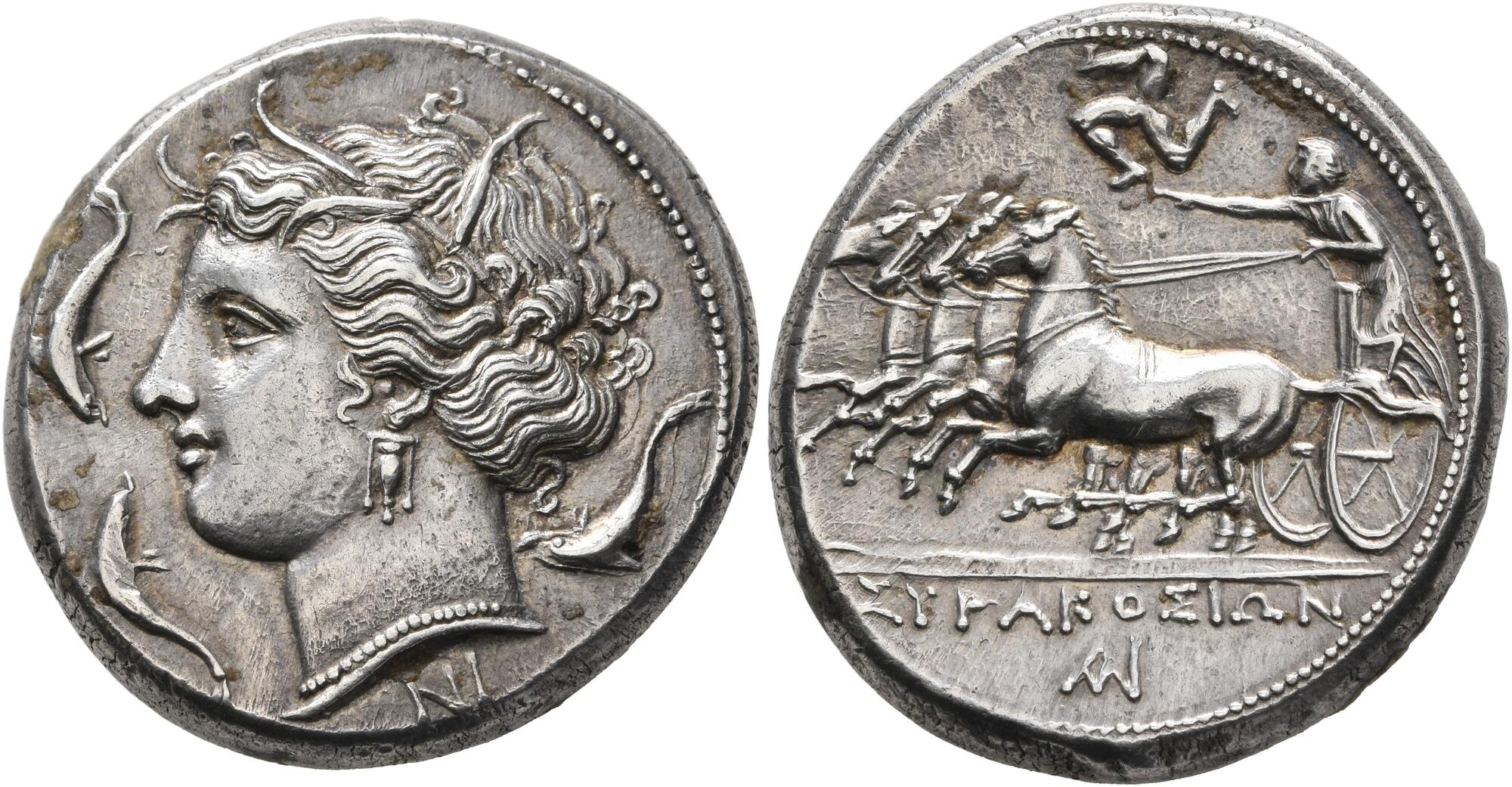Syracuse (Agathocles), silver, tetradrachms (Arethusa/quadriga) (310-305 BCE)
From SILVER
310 BCE - 305 BCE Silver 4,579 kg
Description
| ObverseInscription or printing placed on the obverse.: | Head of Arethusa to left, wearing wreath of grain leaves, triple pendant earring and pearl necklace, around, three dolphins, below neck, NI |
| ReverseInscription or printing placed on the reverse.: | ΣYPAKOΣIΩN (Greek).Charioteer driving quadriga galloping to left, holding kentron in his right hand and reins in his left, above, triskeles running left, in exergue, monogram of AI |
Mint and issuing power
| MintIdentifies the place of manufacture or issue of a numismatic object.: | Syracuse | Ancient regionAncient region.: | Sicily | Modern countryModern country: Italy | AuthorityIdentifies the issuing power. The authority can be "pretended" when the name or the portrait of X is on the coin but he/she was not the issuing power. It can also be "uncertain" when there is no mention of X on the coin but he/she was the issuing power according to the historical sources: | Agathocles of Syracuse (tyrant of Syracuse in 317-289 BC and self-styled king of Sicily in 304-289 BC) |
Chronology
| FromIdentifies the initial date in a range assigned in a numismatic context. | 310 BCE | toIdentifies the final date in a range assigned in a numismatic context.. | 305 BCE | PeriodTime period of the numismatic object.: Hellenistic 323-30 BC |
Physical description
| MetalThe physical material (usually metal) from which an object is made.: | Silver |
Median weightMedian of the weights of numismatic objects (in grams). in grams | 17.10 | DenominationTerm indicating the value of a numismatic object. Examples: tetradrachm, chalkous, denarius.: | tetradrachm |
StandardStandard.: |
Image

S 1518 - Syracuse (Agathocles), silver, tetradrachms (317-305 BCE).jpg [1]
References
| Die study referencePublication of the study: | Riffaud 19891Riffaud 1989 | ||
| Coin series referenceReference to coin series study: | HGC 22HGC 2, n° 1348 | ||
| Coin series web referenceCoin series web references: | |||
Obverse dies distribution
| FrequencyFrequency of specimen in distribution. ᵖ | Number of obversesNumber of obverse dies. ᵖ (o) | % (o) | Number of coinsNumber of coins. (n) | % (n) | Die nameName(s) of the die(s). |
| 1 | 1 | 7.14 | 1 | 0.2 | NIe |
| 13 | 1 | 7.14 | 13 | 2.59 | FIa |
| 15 | 1 | 7.14 | 15 | 2.99 | FIe |
| 17 | 1 | 7.14 | 17 | 3.39 | FIf |
| 20 | 1 | 7.14 | 20 | 3.99 | NIa |
| 25 | 1 | 7.14 | 25 | 4.99 | FId |
| 32 | 1 | 7.14 | 32 | 6.39 | NKb |
| 48 | 1 | 7.14 | 48 | 9.58 | NId |
| 49 | 1 | 7.14 | 49 | 9.78 | FIc |
| 53 | 1 | 7.14 | 53 | 10.58 | FIb |
| 55 | 1 | 7.14 | 55 | 10.98 | NKc |
| 56 | 2 | 14.29 | 112 | 22.36 | NKa, NKd |
| 61 | 1 | 7.14 | 61 | 12.18 | NIb |
| Total | 14 of 14 | 99.97 | 501 of 501 | 100 |
Reverse dies distribution
no distribution is available
Quantification
| Number of obversesNumber of obverse dies. ᵖ (o) | 14 | Number of singletons (o1)The number of singleton coins. ᵖ | 1 |
| Number of reverse diesNumber of reverse dies. (r) | 55 | Number of coinsNumber of coins. (n) | 501 |
| Coins per obverse dieNumber of coins per obverse die. (n/o) | 35.79 | Coins per reverse dieNumber of coins per reverse die. (n/r) | 9.11 |
| Reverse per obverse ratioRatio of obverse dies divided by reverse dies. (r/o) | 3.93 | Percentage of singletons (o1)number of coins (n) divided by the number of singletons (o1) ᵖ | 7.14 % |
| Original number of dies (O) (Carter 1983 formula)The estimation of the number of coins according to Carter 1983 ᵖ | 13.39 | Coins struck if 20,000 as average productivity per dieCoins made if the average productivity for obverses (according to Carter) is 20,000. ᵖ | 267,800 |
| Original number of dies (O) (Esty 2011 formula)The estimation of the number of coins according to the singleton formula in Esty 2011 ᵖ (O) | 14.4 | Survival rate if 20,000 as average productivity per dieSurvival rate if average productivity is 20,000. ᵖ | 0.00187 |
| Coverage (o = % of O) (Esty 1984 formula)Esty 1984 - coverage (% of O) ᵖ (o = % of O) | 99.8% | Die productivity if survival rate 1/2,000Average productivity if survival rate is 1/2,000. ᵖ | 74,831.96 |
| Weight of silver (in kg) if 20,000 coins per die (O = Carter formula)Carter 1983 * Median weight * 20000 (*10 if gold or electrum) ᵖ | 4,579 kg <br /> 4,579 kg | Die productivity if survival rate 1/5,000Average productivity if survival rate is 1/5,000. ᵖ | 187,079.91 |
Remarks
Most likely more than 2 workstations Likely military
"Expression error: Missing operand for *." is not a number.
References
- ^ Riffaud, Jean-Paul (1989), Agathocles de Syracuse, 317-289 avant J.C. : témoignages numismatiques et historiques, Paris, Université de Paris IV-Sorbonne, U.E.R. d'histoire de l'art et d'archéologie, unpublished master thesis
- ^ Hoover, Oliver D. (2012), The Handbook of Greek Coinage Series. 2. Handbook of the Coins of Sicily (Including Lipara). Civic, Royal, Siculo-Punic, and Romano-Sicilian Issues. Sixth to First Centuries BC, Lancaster-London, 489 p.